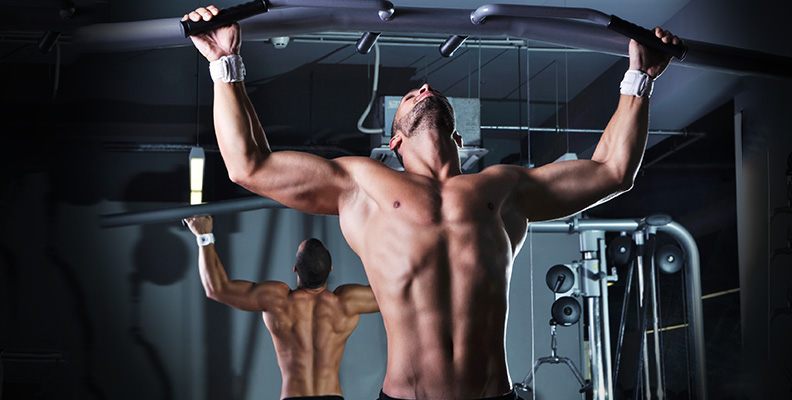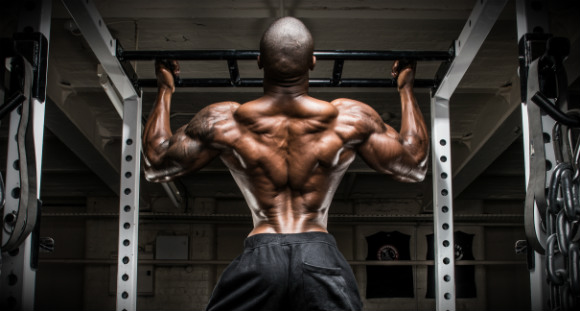Negative pull-ups on the horizontal bar
Negative pull-ups on the horizontal bar: benefits and training program
Pulling on the horizontal bar is a complex movement. Untrained novice athletes, as well as people who by nature have more developed press muscles, and not traction, can not immediately perform it. Negative pull-ups are bringing the chest to the bar in any way possible, for example, from a jump, or with the help of a partner, and slowly lowering the body. Exercise is more promising than moving in a gravitron or other simulator of a simple negative pull-ups.
Negative pull-ups is better than other compensation exercises, as it allows you to quickly understand the technique of lifting the body to the horizontal bar. This version of the exercise strengthens the ligaments, and increases mobility in the joints.
It is good for developing back muscles, biceps, and forearms. Negatives improve grip strength, especially for beginners.

Negative pull-ups execution technique
Initial position
- From the support, go up to the horizontal bar, or use the help of a partner to take the hang. You can jump onto the horizontal bar, but this is a more difficult option for those who can remove the buildup and repay inertia immediately;
- The grip is slightly wider than the shoulders, hands freely grasp the horizontal bar;
- Fingers should not be in an open grip, that is, the thumb also covers the crossbar;
- Then you need to jump or with the help of an assistant to take the upper position, that is, pull your chest to the crossbar;
- It’s better if the assistant will help, since the only way to get through the entire trajectory is exactly as in a normal negative pull-ups
Traffic
- It is necessary to carefully go down;
- The bottom line is that the weight of the body will push down, and it will be difficult to do;
- The athlete must resist the force of gravity, and fall as slowly as possible
Attention
- The athlete should not perform the “repetition” exercise. The goal is to lower as slowly as possible, based on their time under load, sufficient for muscle hypertrophy. Typically, the approach lasts 40 seconds, but the number of repetitions should be as small as possible, and not vice versa;
- Exercise should not be accompanied by jumping from the horizontal bar. The compression load on the knees and spine that occurs when jumping is almost certainly a hello to injury when it comes to a beginner;
- The movement is carried out exactly until the moment when the athlete can not pull himself up. As soon as the main exercise becomes available, we stop doing the lead-ups and focus on the number of repetitions.
Negative pull-ups recommendations
A beginner should start with the grip width, and the direction of the palms that are most convenient for him. For most people, this is a reverse grip and exercise due to biceps and back work, rather than a direct wide grip. As technology is developed, the grip can be changed;
Continuators can use this exercise to increase the result in the usual negative pull-ups “for repetitions” if they perform negatives with weights, that is, with the weight attached to the belt, or in a weighted vest.
Options
Negative pull-up with a stop in amplitude of motion. It is pulling up with fixation – this is work when the body does not fall evenly, the athlete makes stops, and during them tries to achieve full body stability. This allows you to use the muscles in statics, and activate them;
Negatives on one hand. Another exercise that is used by experienced people to increase results in the classic version of the exercise. Pulling on one arm requires good balance and grip strength. If not, use straps.

Program Inclusion
Negative pull-ups are performed on an independent separate day. If the goal is to learn to pull up, you should not train your back with other vertical rods on this day. You can supplement this training with work on the rotator cuff, lifting with a barbell or dumbbells for biceps and 1-2 horizontal pulls on the back, if the athlete maintains such a volume.
Pulling up is the first exercise of the plan, and is put at the end only if the athlete is experienced, knows how to pull up, and does negatives with weighting as an additional movement, which is designed to develop the strength of his latissimus and forearms;
If the goal is to learn how to pull up, at the beginning of each training, the athlete tries to pull himself up, without the help of a partner and not from a jump. If he succeeds, he performs as many repetitions as he can, rests for 5-10 minutes, and proceeds to the negatives.
Grips often fail for beginners, so you should use the most non-slip horizontal bar, apply magnesia to your hands, and fix your hands with straps, if there is no other way to stay in the hang for a long time.
For training purposes, pulling up 3-4 approaches of negatives is enough with 30-40 seconds under load each approach. This will help the athlete gain both grip and muscle strength.
If you can’t learn, despite regular workouts, you should pay attention to posture in general. The shoulders pulled forward are often hindered. The development of rhomboid, latitudinal and posterior deltoids solves these issues.





